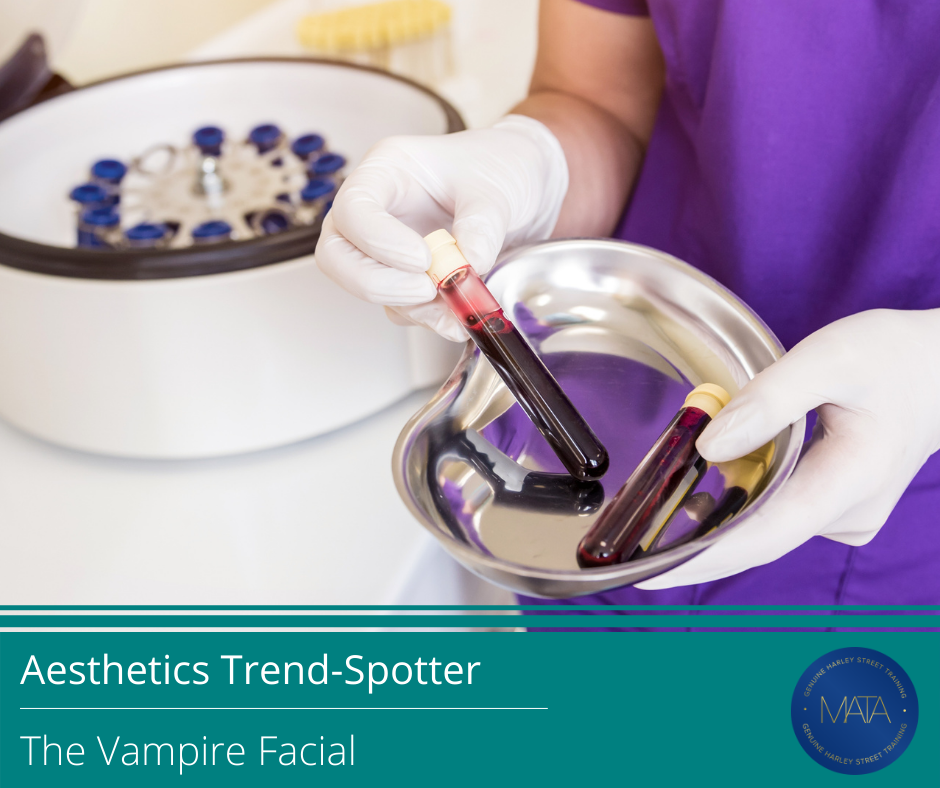
The Vampire Facial has grown hugely in popularity since Kim Kardashian’s 2013 grisly photo of herself midway through treatment, with over 232 thousand mentions on Instagram and 37.6 million views on TikTok. The treatment combines microneedling with platelet-rich plasma derived from the clients’ own blood; and it’s been claimed that the procedure can give a youthful appearance that rivals that created by injectables like Botox or filler.
How Is The Treatment Performed?
Step One – The Blood Draw: The blood is usually drawn from the arm, then placed into a centrifuge and spun to separate the red blood cells and the platelet-poor plasma from the Platelet-Rich Plasma.
Step Two – Facial Cleansing and Numbing: The clients’ face is cleansed and a numbing cream is applied to lessen the pain from the microneedling process.
Step Three – Preparation: The Platelet-Rich Plasma is drawn into a needleless syringe for ease of applying small quantities to the clients’ skin during the facial, and the microneedling device is prepared for use.
Step Four – The Facial: The Platelet-Rich Plasma is smoothed onto sections of the face, followed by the microneedling device. The microneedles push the plasma deep into the epidermis, alongside creating tiny controlled injuries to the epidermis that trigger skin healing and stimulates collagen production.
Downtime From the Vampire Facial
Although the Vampire Facial is ‘non-invasive’, this isn’t necessarily a treatment that clients can fit into their lunch break. It can cause swelling and redness for up to twelve hours following the procedure due to the microneedling process, so clients may prefer to make this an after-work treat.
Results From the Treatment
There isn’t a massive body of research on Vampire Facials. Still, practitioners and clients have reported that after a course of three treatments; the appearance of fine lines, acne scarring and skin roughness are much improved. The results from a course of Vampire Facials should last a client up to 12 months.
Risks of the Vampire Facial
Microneedling alone presents some risk to clients. Bacterial infections can occur if the skin or the machine is not cleansed properly. Clients with darker skin tones are also at risk of Post-Inflammatory Hyperpigmentation (PIH), which leaves darker patches of skin in the treated areas.
When blood is added to the microneedling procedure; other, scarier risks come into play. Two clients at a New Mexico salon in the USA contracted HIV after having Vampire Facials, potentially as a result of cross-contamination. Although this may be an isolated case, it is still something that clients should be aware of before undergoing the treatment.
At MATA, we see non-ablative laser treatment as a safe alternative to the Vampire Facial, improving the appearance of fine lines, scarring and skin texture without breaking the skin or requiring blood handling. To register your interest in our newly restructured Laser and Light qualifications, please complete this webform.
Is the Vampire Facial Here to Stay?
Although the Vampire Facial may have become popular due to a celebrity endorsement, almost ten years on it is still a favourite; available in clinics across the UK and the world. As such, it would seem like the procedure is here to stay. As always, we recommend that clients are made fully aware of the risks and rewards of the treatment. In the case of this particular treatment, we’d also recommend that the procedure takes place in a suitable setting and is carried out by a practitioner with experience in the safe handling of blood products.
Improve Retention, Results and Revenue – Adding a Skincare Line to Your Clinic

If you’re looking to improve retention, results and revenue at your clinic; there is one simple step you can take – adding a line of pharmaceutical grade skincare products.
Incorporating take-home skincare products that complement your aesthetic treatments into your clinics’ offering can come with a range of benefits:
- Adding a pharmaceutical skincare line can create a medium to high profit margin revenue stream at your clinic, to help recoup income from missed appointments or unexpected clinic closures.
- Offering skincare products will allow you to take a holistic approach to your clients’ needs, ensuring that the successful results of your treatments are continued at home.
- As long as the skincare product visibly benefits the client, it will positively keep your clinic at the front of their mind for treatments even in between visits, improving client retention.
Here are the first steps we believe you should take when offering professional skincare and topical treatments to your clients
Choose Your Products
Take the same time and care in choosing pharmaceutical grade skincare products as you would have for the devices and injectable products already at your clinic. Research products fully; checking for active ingredients used (retinoids, vitamin c, hyaluronic acid, niacinamide, etc), along with ensuring that their ingredients and manufacturing process is in line with your clinics’ ethos (for example, cruelty free, vegan, low plastic or recyclable materials), and that the product branding matches in with your own (alternative, punk type packaging wouldn’t mesh with a sophisticated setting, and vice-versa).
We would recommend that you keep your initial product selection small, and focus on products that will enhance the treatment outcomes of your best selling treatments alongside being convenient and easy for your clients to use.You can always increase the products you offer at a later stage, once you have an better understanding of client product needs and preferences
Merchandise Your Products
If you have taken the time to research your new skincare products, then it doesn’t make sense to hide them away. Integrate the skincare line into every element of your clients’ clinic visit – use images of the products in your promotional literature and social media, have them well-displayed in your waiting area or reception, and have them on show and to hand in your treatment rooms. All of this will show your clients that the skincare line is an important part of treatment, rather than something to be treated as an afterthought.
Start Selling Your Products
Before attempting to sell these skincare products to your clients, ensure that you (and your employees) have a complete understanding of the skincare products; from ingredients and manufacturing processes to the benefits of the product and how they fit into a clients’ skincare and aesthetic treatment regime; along with any contraindications and which client group the product is optimal for.
Once you are confident you can answer any question asked, then the product can be introduced to your clients. Build the products into your client conversations from the very beginning, when discussing their skincare needs and concerns. Let clients see and feel the products and ask questions, and even let them apply small amounts of the product if this will not interfere with your treatments. Together, this approach will help drive product sales.

